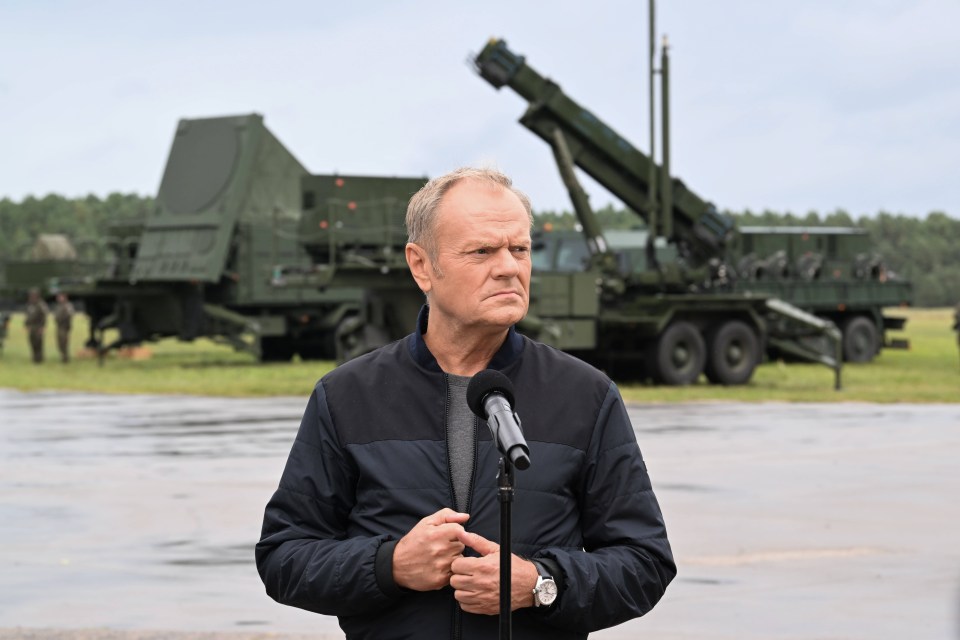POLAND vowed to shoot Russian aircraft in its airspace – and urged Britain to stand with them.
Prime Minister Donald Tusk said there was “no room for debate”.
EPAPrime Minister Donald Tusk speaks during a visit to the Central Air Force Training Area in Ustka, northern Poland[/caption]
EPATwo Russian MiG-31 fighter jets with hypersonic ballistic missiles flying in the sky[/caption]
APRussian President Vladimir Putin chairs a Security Council meeting at the Kremlin in Moscow, Russia, Monday, Sept. 22, 2025. (Alexander Kazakov, Sputnik, Kremlin Pool Photo via AP)[/caption]
He said: “I want to be very clear. We will make a decision to shoot down flying objects without discussion when they violate our territory and fly over Poland.”
He acknowledged it could “trigger a very acute phase of conflict”.
And he said he needed “absolute certainty” that Nato allies would respond “in exactly the same way as we do”.
He was speaking after RAF Typhoons roared over eastern Poland on Friday with orders to shoot down Russian drones.
The Top Guns have joined a Nato mission to bolster its eastern air defences after a spate of Russian violations.
Three Russian MiG-31s spent 12 minutes inside Estonia’s airspace on Friday and two jets overflew a Polish oil rig in the Baltic.
The MiGs only left when Nato jets scrambled to scare them off.
An earlier wave of Russian drones hammered eastern Poland forcing Dutch F-35s to shoot them down.
At least one Russian drone buzzed Romania – triggering German jets to scramble – and others have crashed in Lithuania.
Czech president Petr Pavel has called for Nato military response.
He said: “We must act firmly, and if violations occur, we must respond accordingly, including militarily.”
He added: “This is balancing on the brink of conflict, but giving in to evil is simply impossible.”
The UN Security Council was due to hold emergency talks on Russia’s violations last night.
Russia’s reckless fly-bys have piled pressure on NATO leaders, who now face mounting calls to show muscle on the alliance’s eastern flank.
Estonia branded Friday’s 12-minute incursion “unprecedentedly brazen” and lodged an Article 4 request – demanding urgent NATO consultations over the growing threat.
Prime Minister Kristen Michal raged: “Such a violation is completely unacceptable. NATO’s response to any provocation must be united and strong.”
Tallinn’s foreign minister Margus Tsahkna warned it was the worst breach since 2003, saying: “This is a very serious violation of NATO airspace.”
Colonel Ants Kiviselg, Estonia’s intel chief, added that Russian pilots had blatantly brushed off radio signals from Italian F-35s scrambled to intercept.
“They must have known that they are in [Estonian] airspace,” he said.
Putin’s jets had launched from Petrozavodsk and were tracked by Finnish fighters before being tailed out of Estonian skies.
Moscow insists its planes hugged neutral Baltic waters – a claim rubbished by radar and visual proof.
The crisis has set Europe on edge.
APA drone carrying a bomb flies over during joint Russian-Belarusian military drills[/caption]
EU foreign policy boss Kaja Kallas branded the stunt an “extremely dangerous provocation”, while Lithuania’s defence minister Dovile Sakaliene warned NATO’s frontier “is being tested for a reason. We need to mean business.”
Britain’s shadow home secretary Yvette Cooper blasted it as a “reckless incursion” and demanded tougher economic sanctions on Russia.
Even Washington weighed in, with Donald Trump warning it could spell “big trouble” if NATO unity faltered.
Poland – already Europe’s fastest-arming state – has been on hair-trigger alert since Russian drones smashed into its airspace earlier this month.
Warsaw scrambled jets and activated NATO’s radar shield, calling it the closest the nation has come to conflict since World War Two.
PM Tusk has been pouring billions into tanks, rockets, jets and warships to build what Warsaw boasts will soon be Europe’s biggest army.
The “East Shield” mega-programme to fortify Poland’s frontier with Belarus and Kaliningrad is due by 2028, cementing its frontline role against Moscow.
With Russian propagandists bragging that Poland is next after Ukraine, the stakes are higher than ever.
As Czech president Petr Pavel put it: “Russia will realise very quickly that they have made a mistake and crossed the acceptable boundaries. Unfortunately, this is teetering on the edge of conflict, but giving in to evil is simply not an option.”
What is Article 4?
ARTICLE 4 is a clause in Nato’s founding treaty which states all allies must come together when the security or territory of one is threatened.
Under this clause, members can bring any issue of concern to the table to be discussed.
Since the Alliance’s creation in 1949, Article 4 has been invoked eight times.
Following Russia’s drone incursion into Polish air space, PM Tusk made a request for Article 4 and said: “Allies are resolved to defend every inch of allied territory.”
Nato chief Mark Rutte said the Security Council met yesterday morning to discuss Poland’s request.

